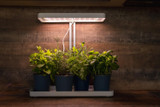How to Diagnose and Fix Problems with High Intensity Discharge Lamps
High intensity discharge (HID) lamps have long been a staple in the hydroponic growing scene, cherished for their ability to emit a powerful and wide spectrum of light. This type of lighting supports robust plant growth, closely mimicking natural sunlight. Thanks to their efficiency and effectiveness, HID lamps are often preferred by those aiming to maintain a thriving indoor garden throughout the year. However, even these reliable light sources can encounter problems that may hinder their performance and, subsequently, the health of your plants.
Common issues with HID lamps can include flickering, unusual color changes, or a complete failure to turn on. Identifying and addressing these problems promptly ensures your plants continue to receive the vital light they need to grow strong and healthy. Understanding how these lamps work and knowing the signs of potential issues are crucial first steps in maintaining an efficient hydroponic system.
Identifying Common Problems with High Intensity Discharge Lamps
Recognizing the symptoms of a malfunctioning HID lamp is essential for any hydroponic gardener. Let's dive into the most common issues:
- Flickering Light: This can indicate a problem with the lamp's ballast or a loose connection. These flickers occasionally start small and sporadic but can become more frequent if not addressed.
- Dimming: A lamp that no longer shines as brightly may be reaching the end of its life. Dimming can reduce the light available to plants, affecting growth over time.
- Color Changes: If you notice the light emitted becoming oddly colored, this might suggest a misalignment within the bulb or a problem with the inner components.
- Failure to Turn On: When the lamp refuses to ignite, it could be a sign of a faulty connection or a burnt-out bulb needing replacement.
Each of these issues can impact your garden's light supply, impacting plant growth and health. By spotting these signs early, you can take action before they escalate into more significant problems, potentially saving your plants from insufficient light. Understanding these common problems helps ensure your hydroponic system remains efficient and your plants continue to thrive.
Diagnosing High Intensity Discharge Lamp Issues
Once you spot signs of trouble with your HID lamps, it's time to diagnose the problem. Start by examining each component to pinpoint the issue. Here’s a step-by-step guide to help you through the process:
1. Check the Power Source: Ensure that the lamp is properly connected to the power outlet and that the circuit breaker isn’t tripped. Sometimes, a loose plug or a flipped switch might be the culprit.
2. Inspect the Bulb: Gently remove the bulb from its socket after switching off the power. Look for any blackening or signs of burnout. If the bulb appears damaged or old, replacing it could be the simple fix you need.
3. Examine the Ballast: The ballast regulates the current to the lamp. If it's damaged, it can cause flickering or dimming. Listen for any buzzing sounds, which might indicate a faulty ballast. Check for any visible damage as well.
4. Review the Connections: Loose or corroded connections can lead to poor performance. Inspect the wiring and connections, ensuring everything is secure and clean.
When handling any part of the lamp, make sure the power is off to prevent accidents. These steps should give you a good foundation for diagnosing common issues with your HID lamps.
How to Fix Problems with High Intensity Discharge Lamps
Once you have identified the problem, it's time to consider solutions. Here are some common fixes:
- Replace the Bulb: If the bulb is faulty or nearing its lifespan, swapping it out with a new one can restore full brightness and function.
- Repair or Replace the Ballast: If you determine the ballast is the problem, fixing or replacing it might be necessary. Handling electrical components can be tricky, so consulting with a professional is often a wise choice.
- Clean the Fixture: Dust and debris can interfere with the lamp's function. Regularly clean the fixture to ensure optimal performance.
Sometimes fixing these problems might seem manageable, but if they persist, seeking professional assistance is a good idea. Skilled technicians can provide precise solutions, ensuring your hydroponic system runs smoothly.
Preventive Maintenance for High Intensity Discharge Lamps
Proactive maintenance can keep your HID lamps in tip-top shape, minimizing the risk of unexpected issues. Here are some tips:
- Regular Inspections: Set a schedule for regular checks of your lamp components. Look for signs of wear or damage and address them promptly.
- Keep It Clean: Clean the lamp fixture regularly to prevent dust from clogging any parts. Remember, less dust means more efficient light.
- Monitor Performance: Pay attention to how your lamps perform over time. Early detection of minor changes can prevent major problems later.
By staying on top of maintenance, you extend the life of your HID lamps and keep your garden thriving.
Keep Your Hydroponic Garden Bright and Healthy
Ensuring that your HID lamps function optimally is key to maintaining a healthy hydroponic garden. When these lamps are working well, they provide the strong, consistent light needed for your plants to grow vibrant and robust.
By understanding and addressing potential lamp issues early, you'll ensure your green space remains flourishing. Lamp care is an ongoing journey, and with the right steps, your hydroponic system will continue to support joyful growth and bountiful harvests.
With proper care and timely solutions, your hydroponic garden will continue to flourish under the bright, consistent light of HID lamps. If you're looking to better understand your lighting setup or explore upgrade options, take a look at how high intensity discharge lighting supports strong plant growth. Trust Shore Grow to support your growing needs every step of the way.
Recent Posts
-
How to Adjust LED Grow Light Settings for Optimal Growth
LED grow lights have become a favorite tool for many cannabis growers, thanks to their efficiency an …Oct 29th 2025 -
Must-Have Lighting Accessories for Any Grow Room
Starting a cannabis grow room can be quite an adventure, especially when it comes to picking the rig …Oct 29th 2025 -
Tips for Resolving Inefficiencies in High Intensity Discharge Lamps
High Intensity Discharge (HID) lamps play a crucial role in hydroponic cannabis cultivation, offerin …Oct 22nd 2025




